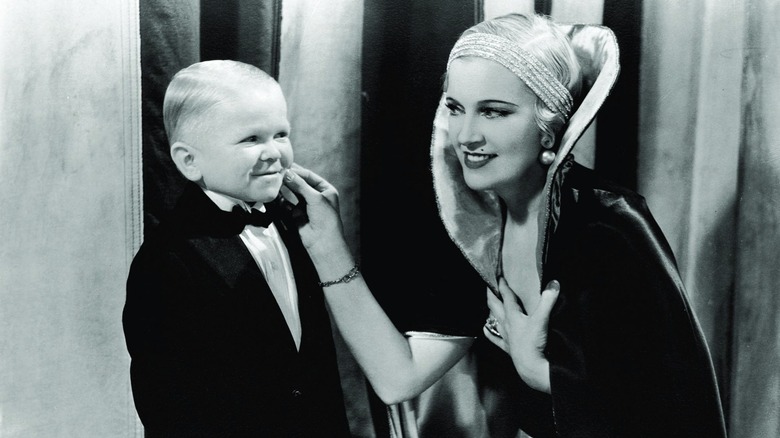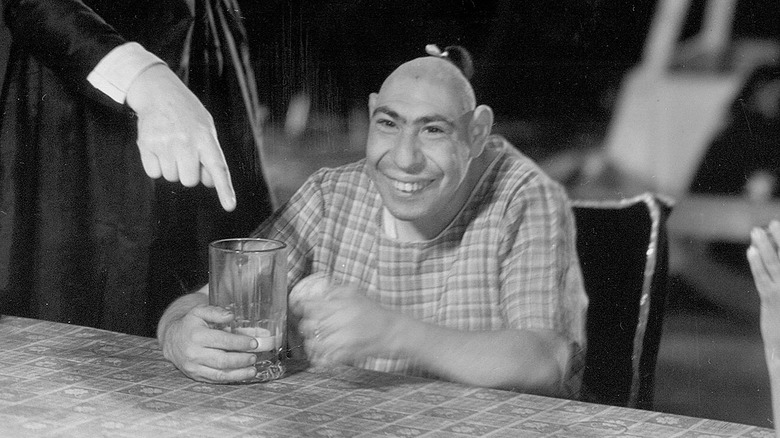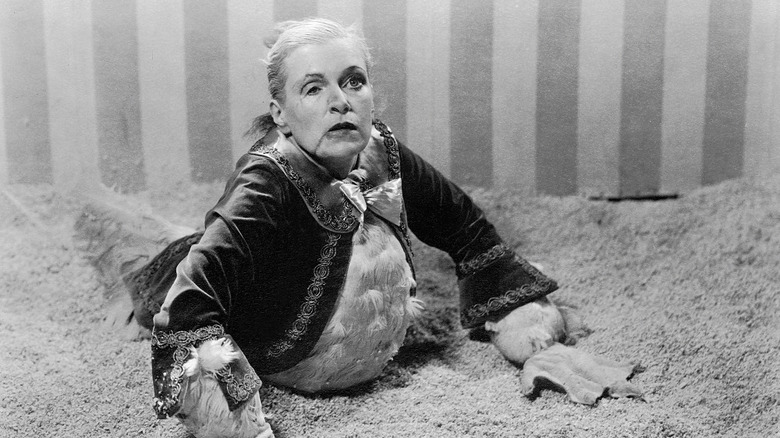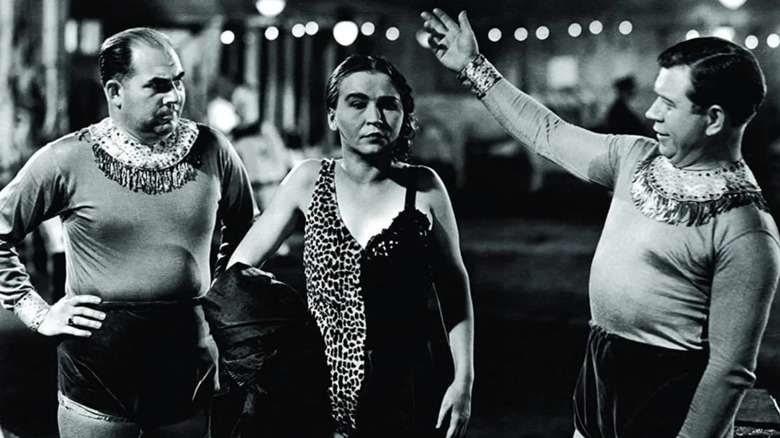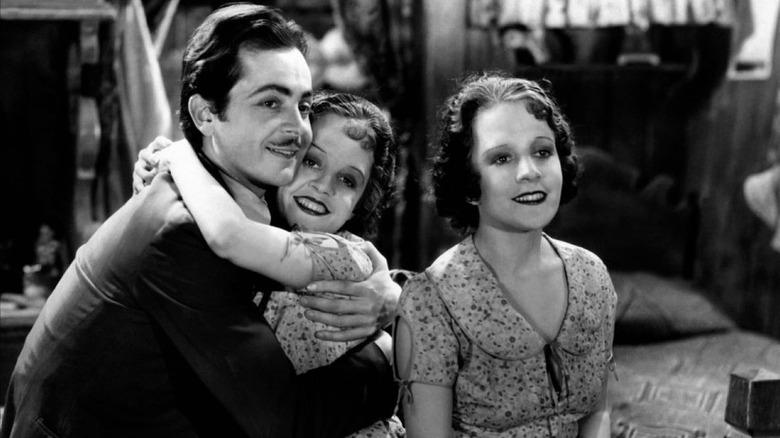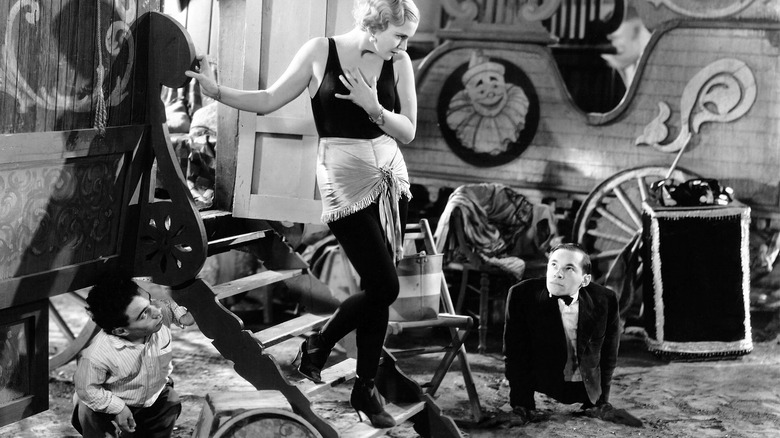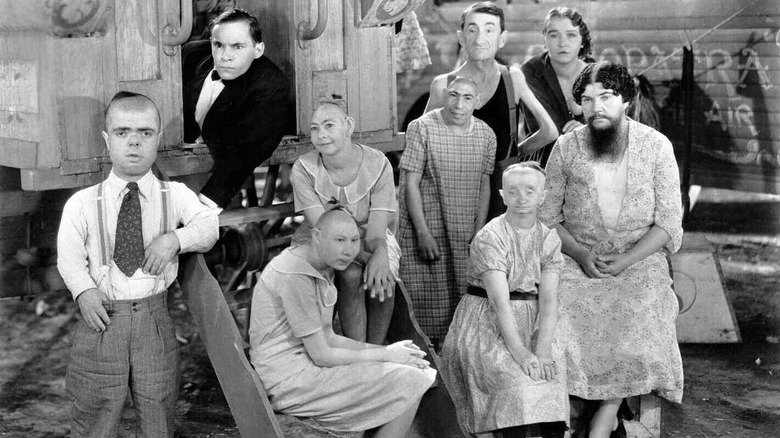Freaks Controversy Explained: Was Tod Browning's 1932 Horror Movie Exploitative Or Progressive?
"Freaks" is one of the most impactful films ever made about humanity's cruelty and the power of solidarity. It tells the story of a beautiful but conniving trapeze artist named Cleopatra who plans to seduce and murder Hans, a circus sideshow performer and a person of short stature, for his inheritance. Director Tod Browning's dark film was a critical and box office failure during its 1932 release because of its unflinching depiction of persons with disabilities, causing it to fade into obscurity for many years.
Today, many critics debate whether or not "Freaks" is an exploitative product of its time or actually sympathetic towards the sideshow characters. It spotlights persons with all sorts of disabilities such as dwarfism (the siblings Harry and Daisy Earles), sacral agenesis (Johnny Eck), conjoined twins (Daisy and Violet Hilton), microcephaly (Schlitzie), and more. Yet at the same time, the film contains terrifying scenes where the "freaks" are portrayed as the horrifying aggressors. How then do we interpret the film's storied history and representation of disability?
Segregation on set
Tod Browning brought his own adventures as a circus performer to "Freaks"; starting at 16, he was a roustabout, barker, contortionist, and clown. Instead of casting non-disabled actors and using makeup or special effects, Tod Browning wanted to use the kind of persons with disabilities that he knew from his work experience and childhood fascination with carnivals. This comfortability allowed him to establish a good working relationship with the "freaks" ensemble.
However, not everyone at MGM was friendly towards them. When studio president Louis B. Mayer saw the sideshow entertainers, he was reportedly "horrified" and tried to have the picture shut down; producer Irving Thalberg had to convince him otherwise. The studio heads wanted to ease the ableist tensions between the performers on set, so the actors with disabilities were unfairly segregated in a tent when not filming scenes. They also ate in a separate cafeteria so that "people could get to eat in the commissary without throwing up," story editor Samuel Marx harshly stated (via "Hideous Progeny: Disability, Eugenics, and Classic Horror Cinema" by Angela Smith). There was little to no inclusivity on set and the able-bodied cast and crew made the carnival performers feel ashamed of their differences.
The circus performers with disabilities were most likely paid less than the able-bodied stars and only offered a middling amount. Johnny Eck was paid around $35, the equivalent to $756.91 today. On the other hand, Browning boasted that he was paid around $150,000, but Horror Film History says that may have been a "showman's exaggeration." Nevertheless, there was clearly a hard line drawn between the disabled and able-bodied performers in both professional compensation and accommodations, unjustly dividing them.
A terrifying ending
In the film, the "freaks" band together as outcasts from society, forming their own makeshift family. Despite being able-bodied and conventionally beautiful, they declare Cleopatra as "one of us" because they believe she is a sympathetic friend and truly in love with Hans. Eventually, they discover her plot to murder Hans and her affair with Hercules, another employee of the carnival.
Cleopatra escapes to the forest and in one of the film's most horrifying shots, the "freaks" crawl after her beneath Hans' overturned wagon, their bodies wriggling in the pouring rain. What makes this scary is the way it is shot, not because it depicts persons with disabilities. The combination of the stark shadows and the thick mud make it difficult to see what's coming, and the only sound we hear is the storm and Cleopatra's terrified screaming. It's unsettling to imagine being chased by someone with so much vengeful anger.
There is a fade to black after the "freaks" capture Cleopatra and in the next scene we see she has been transformed into a squawking "human duck" on display for carnival patrons; her tongue has been removed, one eye has been gouged out, the flesh of her hands has been melted and deformed to look like duck feet, her legs have been cut off, and what is left of her torso has been permanently tarred and feathered. It's a spine-tingling image that burns into your brain.
The ending is a double-edged sword. "Freaks" shows how Cleopatra is cold and malicious towards the sideshow entertainers and we can empathize with them wanting to retaliate. It's understandable that they want to protect their loved one and themselves from further ostracization. On the other hand, this ending frames the "freaks" as violent and scary just because they look different and could make someone else look different, too.
Test screening reactions and censorship
The film originally had a different ending that supposedly made audiences so sick that they ran out of the theater; one woman threatened to sue MGM because she claimed "Freaks" caused her to suffer a miscarriage (via "Hideous Progeny: Disability, Eugenics, and Classic Horror Cinema" by Angela Smith). The reports that "Freaks" made audiences ill could have been a publicity stunt to sell the film as a horror feature for able-bodied audiences.
"Freaks" initially ran 90 minutes before it was whittled down to its final 64 minute version that features alternate footage. Unfortunately, the original print that drew so much controversy no longer exists, but the screenplay gives us an idea of what audiences were so disturbed by on screen. There was more footage of Cleopatra's agonizing screams as the circus entertainers attacked her, followed by the police's petrified discovery of her body.
In the original ending, two of the able-bodied characters — Venus and Phroso — visit Hercules, who performs a falsetto song because he has been castrated. Cleopatra quacks along as the duck with the extra chilling detail that she is now senseless: she cannot speak and understands nothing. The duck revelation still features in the final film, but is less detailed. This version also ends on a somewhat happy note with the reconciliation of Hans and Frieda.
The theatrical release was still met with controversy, banned in the United Kingdom and pulled from several United States theaters after being labelled "brutal and grotesque" (via The Telegraph). It's disheartening to learn that 1930s audiences were so frightened and revolted by the mere sight of persons with different abilities and physicality. It's a bigoted perspective and the unfounded backlash prevented a fascinating film from receiving its due attention.
Critic responses have changed over time
During its initial release, some reviewers praised Tod Browning's sumptuous visuals and daring perspective, celebrating the film for achieving a haunting sensationalism few others had. But the majority lambasted the film simply for its inclusion of persons with disabilities. Despicable language colors their negative reviews.
"There is no excuse for this picture. It took a weak mind to produce it and it takes a strong stomach to look at it," The Kansas City Star wrote; The Hollywood Reporter echoed this sentiment, stating "Freaks" was an "outrageous onslaught upon the feelings, the senses, the brains and the stomachs of an audience." Variety castigated the film for being "impossible for the normal man or woman to sympathize with the aspiring midget," referring to the character of Hans. All of these reviews reflect the shameful ableist attitudes of that time period (via TCM).
It was not until the late 1960s that "Freaks" was critically reexamined for its themes of oppression and subversion of societal norms. A retrospective review in Film Quarterly deemed Browning's film a "masterpiece." In 2003, Slant Magazine wrote an essay about how the moral significance of "Freaks" has been obscured by its "shocking" elements and the voyueristic responses of 1930s audiences; writer Ed Gonzalez notes that many ignore an important element:
"[T]he film's blistering humanity ... and philosophical lengths to which Browning goes to challenge the way we define beauty and abnormality."
Looking closely at "Freaks" beyond its damaging history we can see an empathetic quality that makes the film ahead of its time.
A peek into their daily lives
One of the more positive aspects of disability representation in "Freaks" is its showcase of the sideshow performers going about their domestic routines — such as lighting a cigarette or doing laundry — in a casual manner. Through these naturalistic vignettes, the viewer comes to see the "freaks" as more than just voyueristic objects but individuals who happen to have some physical limitations and perform everyday activities a little differently. Browning also presents the carnival as a utopia where persons of all abilities can peacefully coexist. There is no real distinction between the circus performers, able-bodied or not, because they all get along and interact as friends. There is no segregation — unlike the MGM "Freaks" set.
Aside from the ending where the "freaks" seek their violent revenge against Cleopatra, they are not the villains as they would be in any other "monster" film during that time period. Instead, the physically ideal Cleopatra is the cold-hearted and devious one, countering the belief that physical appearance equates to someone's social value and moral fiber. Browning frames the circus performers with disabilities as caring, kind-hearted people with romantic relationships, sex lives, and friendships. They share a close bond with persons of all abilities, but they form a particular alliance with one another against ableism.
During the 1930s, there was a ghoulish obsession with eugenics, wanting to eradicate persons with facial and body differences and promoting "fitter families" and "better babies" — those who were white, able-bodied, and wealthy. Browning boldly rejects this cultural movement by asserting that persons with disabilities can get along in society and with others and are worthy of respect.
Considering the film today
Much of Browning's work critiques societal beauty standards and "Freaks" is no different. His film gazes at the sideshow performers with sensitivity. Through the character of Cleopatra, Browning castigates a world that treats persons with disabilities with such disgust and disdain. Without the balance in the beginning of the film that shows the "freaks" in their daily lives, they would be seen as pure villains when they finally reach their breaking point and retaliate. Browning also includes dialogue exchanges that support the film's anti-eugenics perspective. In the opening, one of the onlookers gawking at the "freaks" is reassured that they are equal to everyone else:
"How many times have I told you, not to be frightened? Have I not told you, God looks after all his children?"
This echoes another sentiment at the end of the film:
"You laughed at them, shuddered at them. And, yet, but for the accident of birth, you might be one as they are. They did not ask to be brought into the world. But, into the world they came."
These statements support a more inclusive society and rejects those who shun persons with disabilities for merely existing.
The very nature of the horror genre forces audiences to fear deformity, which complicates our reception of "Freaks." The culture surrounding the production and reception of "Freaks" in the 1930s was undoubtedly ableist and cruel, but the film itself and Browning's intentions are not entirely exploitative. There is strong evidence of his compassion that runs throughout the film and defies the eugenics thinking during that era. 90 years later, "Freaks" is the only U.S. film to have a predominantly disabled cast. We should advocate for more films featuring persons of all disabilities so that their representation is more nuanced.
